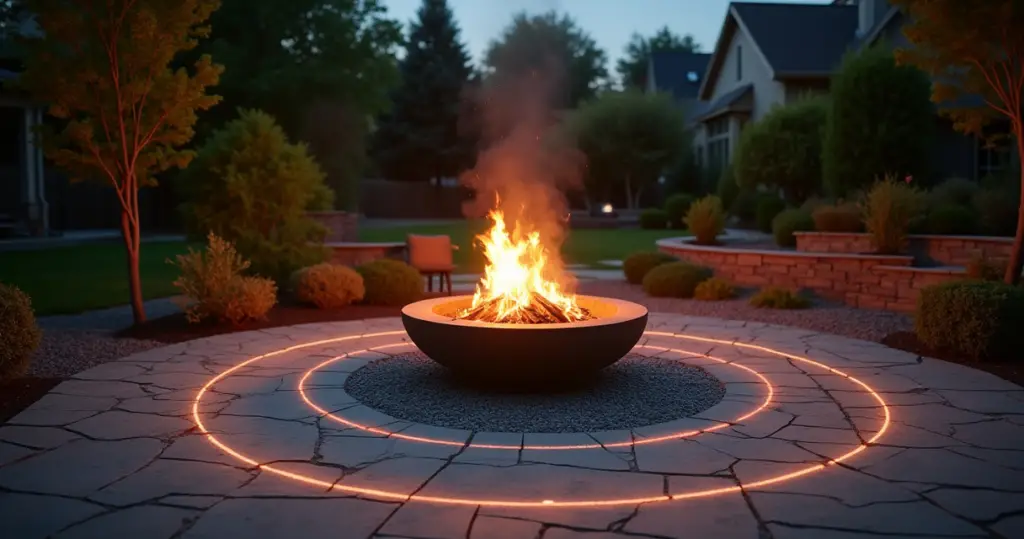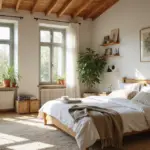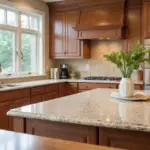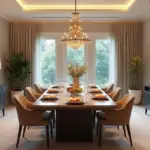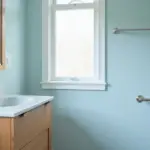Picture this: You’re standing in your yard as the desert air begins to cool. The sun has just dipped below the horizon, painting the sky in deep indigos and dusty pinks. You press a button—or perhaps you strike a match, enjoying the small ritual—and a line of flame whispers to life. It’s not just a pit of fire; it’s the heart of an outdoor room, an anchor that draws people in. This is the goal.
My work lives at the intersection of two worlds: the ancient wisdom of Middle Eastern architecture, which mastered the art of creating cool, communal courtyards, and the quiet simplicity of Scandinavian design, which finds beauty in function and warmth in minimalism. A firepit, when done right, embodies both. It’s a space for community, a source of warmth, and a focal point of elegant simplicity. Forget the flimsy metal bowls and sad circles of plastic chairs. We’re going to talk about creating a space with intention.
Foundational Planning & Safe Placement Strategies
People always want to jump to the fun part—the materials, the shape, the seating. But a fire feature that isn’t built on a thoughtful foundation is, at best, a temporary pleasure and, at worst, a serious hazard. This first stage is about respecting the element you’re inviting into your space. It’s the silent, invisible work that makes everything else possible.
1. Determine Optimal Clearance for Maximum Safety
You know what people always ask me? “Is 10 feet really necessary?” Yes. And in some climates, especially my beloved desert, I’d argue for more. This isn’t just a random number spit out by an insurance company. It’s about understanding that heat radiates, and embers can travel on the slightest breeze. In an arid landscape, where every plant is precious and the line between your home and the wild is thin, respecting this distance is paramount. It’s a buffer that protects your home, your landscape, and the people you’ve invited to share your space.
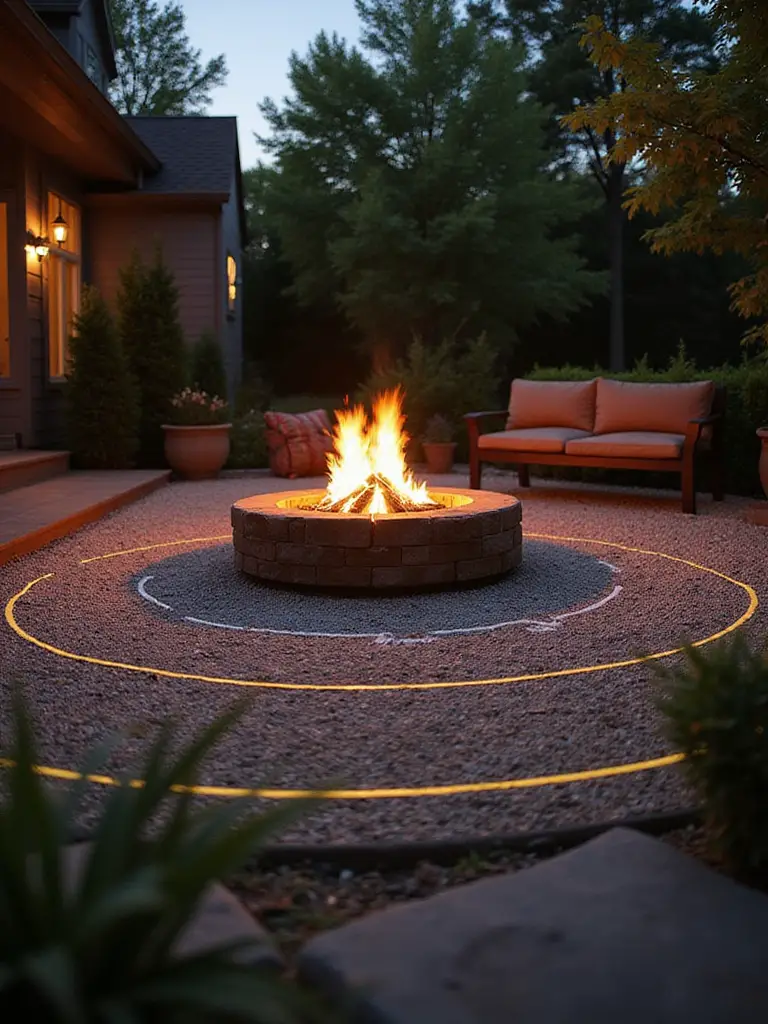
A client once wanted to tuck a firepit close to a stunning, mature palo verde tree to get that “under the canopy” feeling. I had to be the one to tell them no. Radiant heat, even if it doesn’t cause a fire, can slowly cook the cambium layer of a tree, killing it from the inside out over a few seasons. True design works with nature, not against it. Think of clearance not as a restriction, but as giving the fire—and your landscape—the breathing room it deserves.
A firepit built with respect for its surroundings brings a sense of peace; one that pushes the limits creates a subtle, constant tension.
2. Evaluate Local Codes and HOA Rules
Can we just agree that the most expensive firepit is the one you have to tear out? Before you sketch a single design, the first and most crucial conversation is with your local municipality and, if you have one, your HOA. They’re not just being difficult; these rules are born from local conditions—wind patterns, wildfire risk, population density. Ignoring them is pure folly.
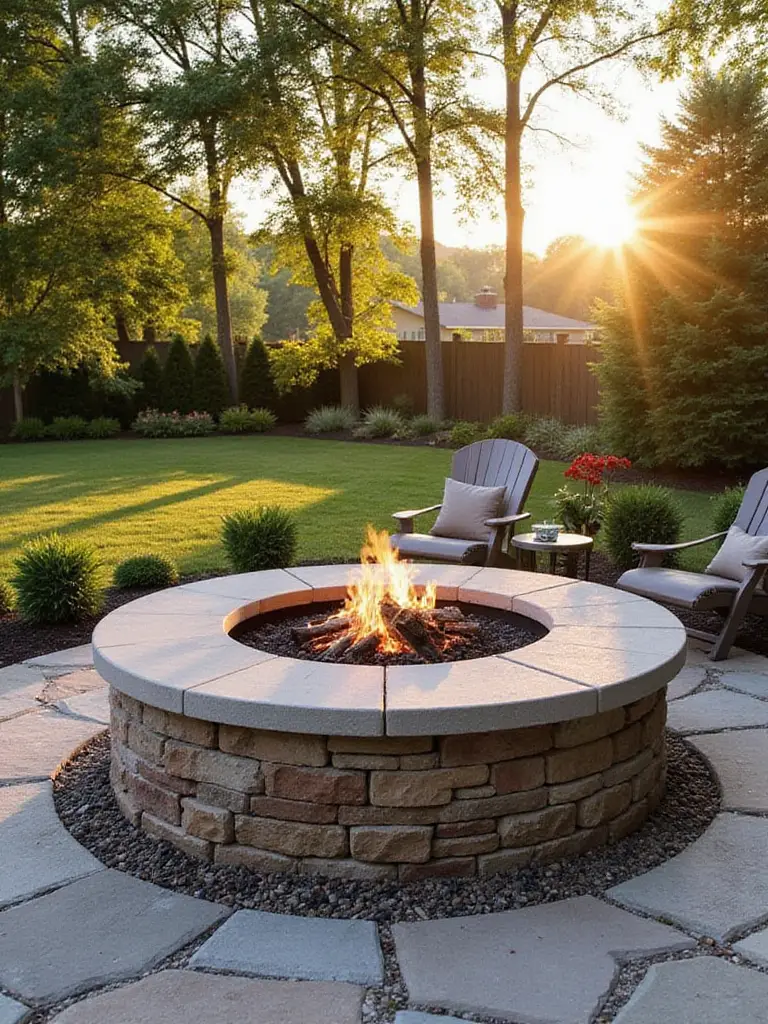
I once consulted on a project where a homeowner had built a gorgeous, sprawling masonry firepit, only to be told it violated setback codes by two feet. The fines were one thing, but the cost of deconstruction and rebuilding was heartbreaking. Don’t learn this the hard way. Make the phone calls. Get the permits. Document everything. Consider it the unglamorous but essential first step in creating something that will last.
This isn’t about navigating bureaucracy; it’s about being a responsible steward of your property and a good neighbor.
3. Choose Between Wood and Gas
This isn’t about which is “better.” It’s about honesty and a simple question: What is the rhythm of your life? A wood fire is a ritual. It’s the process of stacking the logs, the patience of coaxing a flame, the scent of smoke, the physical act of tending to it. It requires time and a certain state of mind. It’s beautifully primal. A gas fire, on the other hand, is about immediacy. It offers warmth and ambiance at the touch of a button, fitting seamlessly into a busy weeknight. There is no romance in shivering while you try to get damp wood to light.
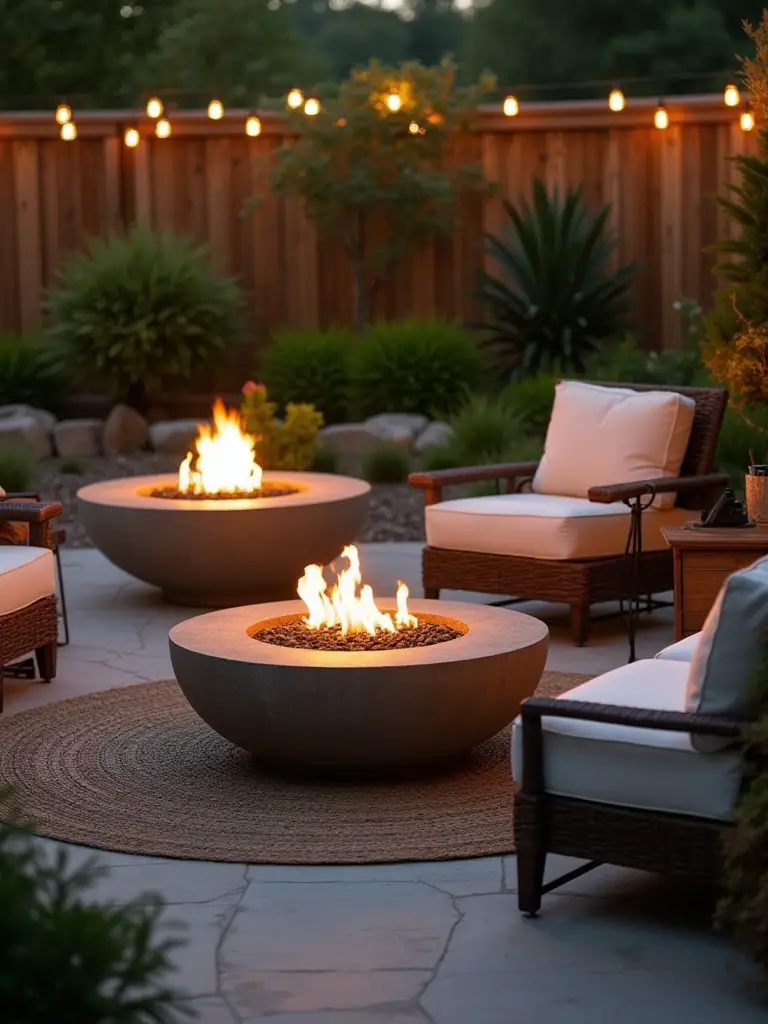
A confession: I used to be a wood-burning purist. I believed it was the only “authentic” way. Then I designed a space for a busy family with two young children. They wanted to have 20 minutes by the fire after dinner, a small moment to connect during the week. A gas fire gave them that. The ease of it meant they used the space constantly, whereas a wood fire would have been a weekend-only affair. So, ask yourself: Are you seeking a ritual to slow down with, or are you seeking to integrate warmth and gathering into the fast-paced moments of your daily life? Your answer will tell you everything you need to know.
One is not superior to the other; they simply serve different human needs.
4. Prepare a Stable, Non-Combustible Base
The ground beneath your firepit is its anchor. It’s the unsung hero of the entire structure. Placing a heavy masonry feature on uncompacted soil is like building a house on sand. Over time, with rain and ground shifts, it will settle, tilt, and crack. This isn’t just an aesthetic issue; it’s a structural failure waiting to happen. Whether you’re setting a simple steel bowl or building a massive stone feature, the base is everything.
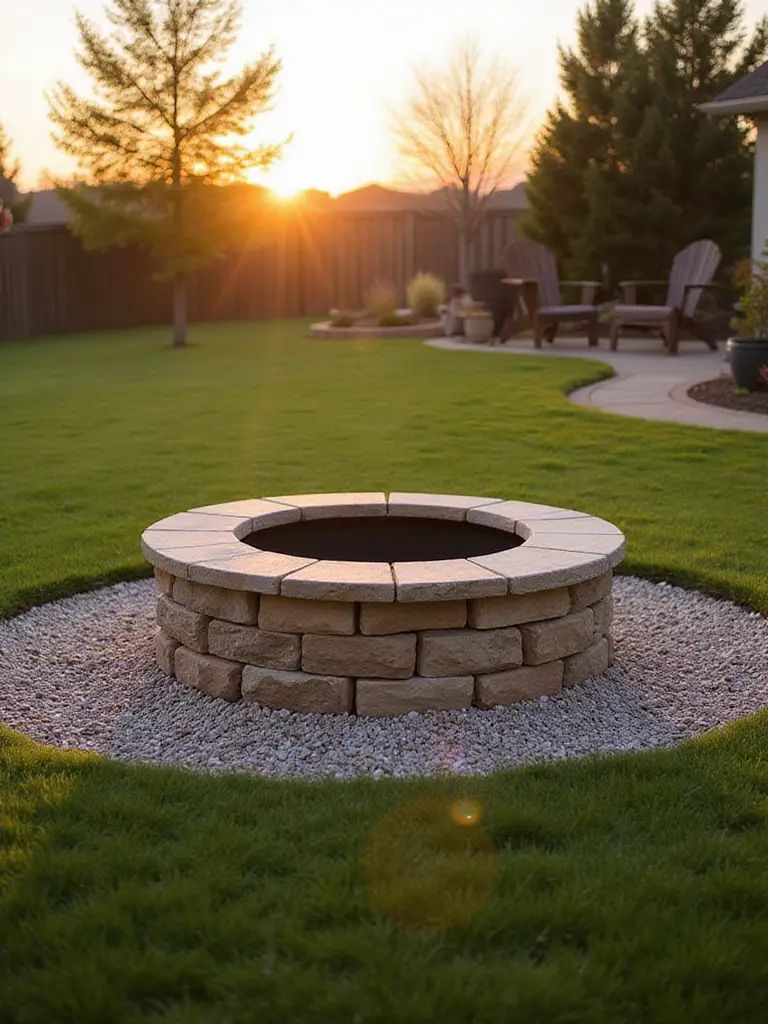
I always advocate for excavating the area and laying a compacted base of crushed gravel, followed by sand or pavers. This creates a stable, level foundation that allows for drainage and prevents the shifting that can compromise the entire structure. For built-in masonry, a reinforced concrete pad is the ultimate insurance policy. Think of it as the responsible choice that protects your investment, ensuring your fire feature remains a source of joy, not a perpetual maintenance headache.
This isn’t just about what you see; it’s about honoring the forces you don’t—gravity, water, and time.
5. Incorporate Effective Windbreaks
My Middle Eastern heritage taught me the profound wisdom of the courtyard. For centuries, architects in harsh climates have used walls, screens, and sunken gardens to create sheltered microclimates—calm, protected spaces shielded from searing sun and relentless wind. This is the principle you should apply to your firepit. A fire battling the wind is a frustrating, smoky, and frankly dangerous thing. The flames are whipped into a frenzy, heat is carried away, and embers are scattered.
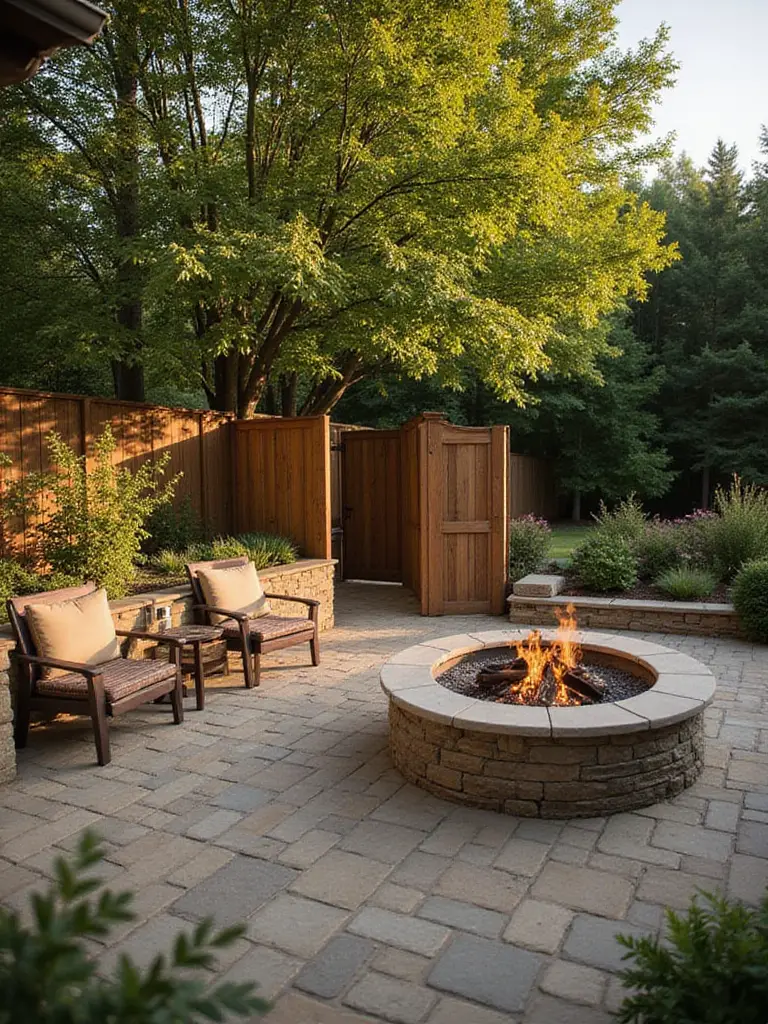
A well-placed wall, a dense hedge, or even a semi-permeable slatted screen can transform the experience. It tames the wind, allowing the flames to rise vertically and the heat to radiate evenly. This creates a pocket of stillness, a true sanctuary. You’re not just blocking the wind; you are consciously shaping the environment to create comfort and safety. You’re building a modern courtyard.
A windbreak turns a battle against the elements into a harmonious collaboration with them.
6. Establish a Guiding Budget
Let’s be direct. A budget isn’t a limitation; it’s a tool for creativity. Everyone says to “set a budget,” but they rarely talk about why. It’s not just to stop you from overspending. It’s to force you to make intentional choices. When you have infinite options, you can get lost. When you have clear parameters, you start asking the right questions: What matters most to me? Is it the authenticity of natural stone, or the efficiency of a gas insert? Is it seating for ten, or an intimate space for two?
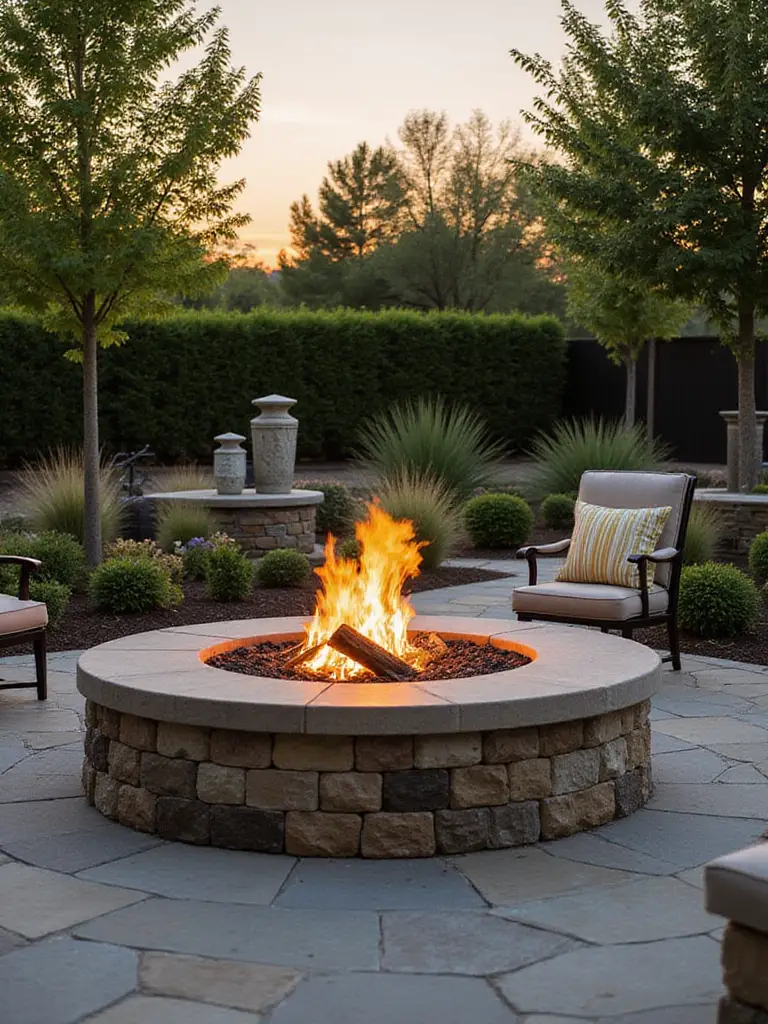
I’ve seen clients with a vague budget chase every shiny new idea, ending up with a collection of features that don’t quite cohere. In contrast, clients with a well-defined budget are focused. They might choose to invest in incredible stonework for the pit itself and opt for simpler, more affordable seating. Those trade-offs are what give a project its soul. Always, always, build in a 15% contingency. It’s the buffer that allows for unforeseen issues without derailing the entire vision.
A budget doesn’t restrain your dream; it gives it shape.
Inspiring Design & Material Selection Concepts
With the foundational work done, we can now turn to the soul of the space. This is where we choose the materials that will tell a story, the forms that will shape our interactions, and the details that will integrate the firepit into the broader landscape of your home and life. This is the poetry built upon the grammar of the foundation.
7. Select Durable, Soulful Materials
I have a pet peeve: “low-maintenance” materials that are essentially plastic. True longevity comes from materials that age with grace. Stone that gathers moss in the cracks, Corten steel that blooms into a stable, velvety rust, concrete that develops a unique patina. These materials have a soul. They change with the seasons and tell a story over time. They connect your modern space to the geological time of the earth.
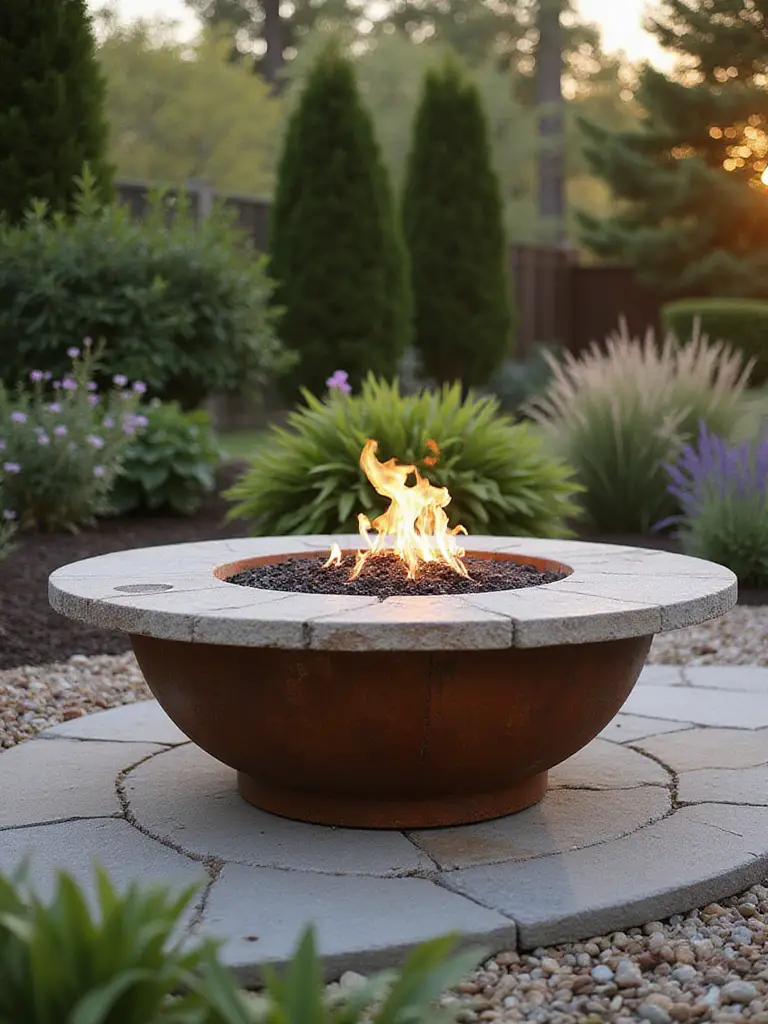
When choosing, think beyond the initial look. How will this material feel under your hand? How will it look after a decade of sun and rain? High-duty firebrick on the inside is non-negotiable—it’s what protects your beautiful exterior material from the intense, direct heat. But for that exterior, choose something that feels honest to your landscape and your home. In the desert, I gravitate toward rammed earth, limestone, and steel—materials that speak the language of the environment.
Don’t just build a firepit. Build a ruin of the future. Choose materials that will be beautiful even after we are gone.
8. Design Integrated Seating for a Communal Feel
Everyone thinks a firepit is just the pit. They’re wrong. The firepit is the pit and the space around it. The biggest mistake I see is a firepit dropped onto a patio with a ring of mismatched, portable chairs. It feels transient and disconnected. Integrated seating—a low wall, a built-in bench—transforms the entire dynamic. It creates a sense of permanence and enclosure, a space that says, “Stay a while.”
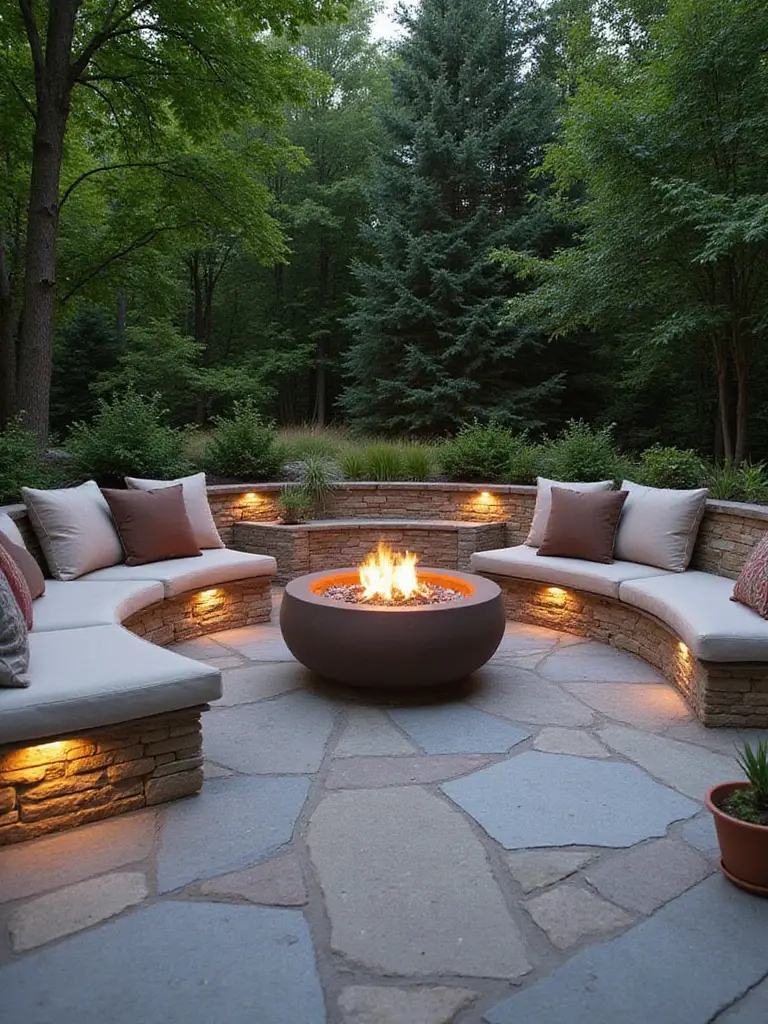
In the Middle East, the majlis is a central concept—it’s a designated space for gathering and conversation, often lined with built-in seating. This architecture instinctively draws people together. A curved seating wall doesn’t just provide a place to sit; it orients everyone toward the fire and each other. It fosters a more intimate, communal atmosphere than any collection of individual chairs ever could. It’s the difference between a waiting room and a living room.
You’re not just building a place to sit; you’re shaping the nature of the conversations that will happen there.
9. Choose an Ideal Size and Scale
The biggest BS line in design is “go big or go home.” When it comes to a firepit, the right size is the one that is in harmony with its surroundings. Scale is everything. A massive firepit in a tiny courtyard feels aggressive and claustrophobic. A tiny fire feature in a sprawling landscape looks lost and insignificant. It’s about creating a balanced composition.
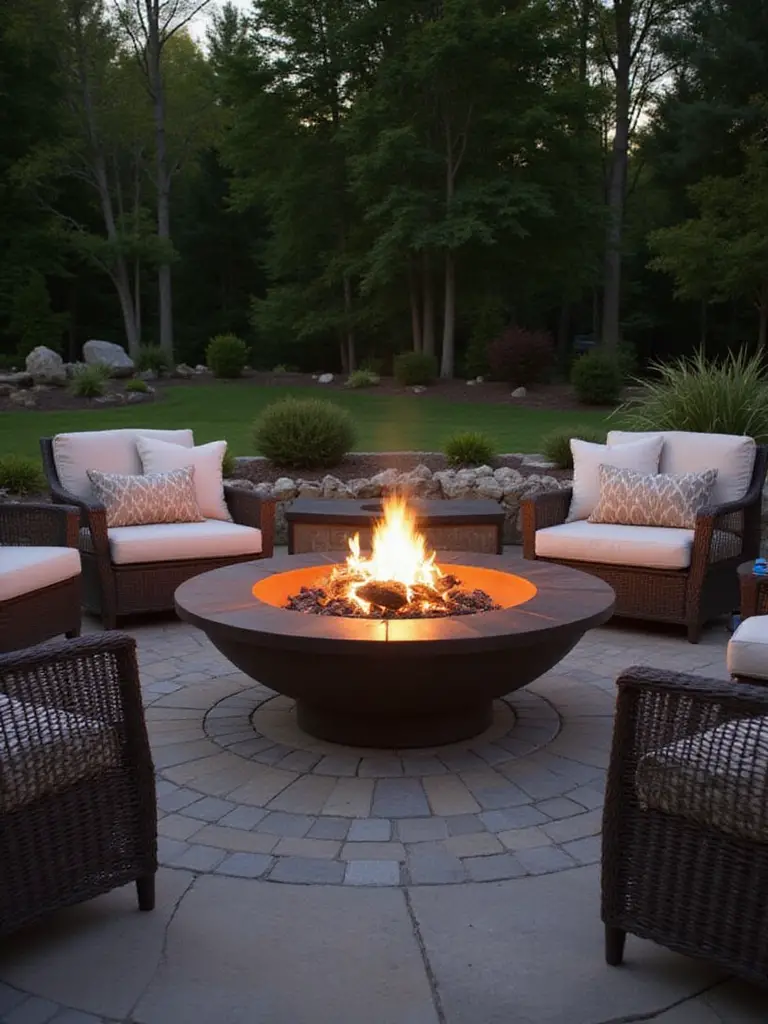
The shortcut here is to mock it up. Before you buy or build anything, use a garden hose, some string, or even a cardboard cutout to outline the footprint of the firepit and its surrounding seating area. Live with it for a day or two. Walk around it. Does it feel generous or cramped? Does it command the space or get lost in it? This simple act of visualization can save you from a costly and deeply unsatisfying mistake. It ensures the firepit feels like a natural part of the whole, rather than an awkward afterthought.
Proportion is the silent language of good design.
10. Explore Unique Shapes and Layouts
A circle is classic, a square is modern, but your space might be asking for something different. A long, linear firepit can beautifully define the edge of a patio, acting as a fiery barrier that draws the eye toward a view. An L-shaped pit integrated into a seating corner can create distinct conversation zones, perfect for larger gatherings. Think of the shape not as a container for fire, but as an architectural element in its own right.
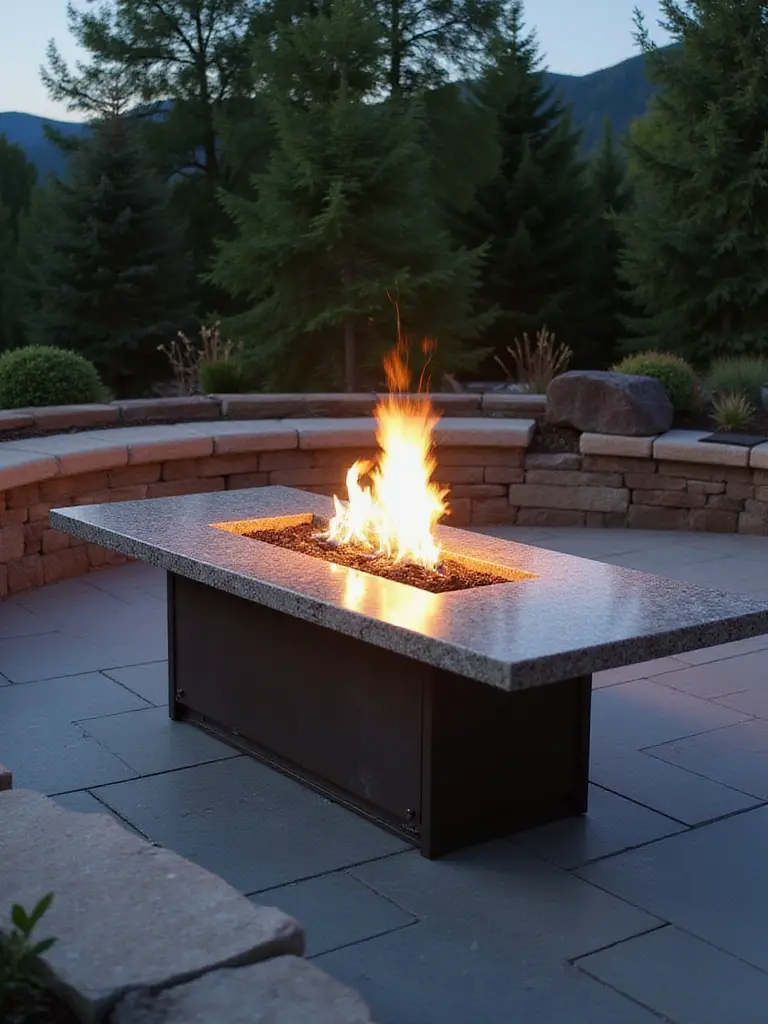
I recently designed a space where a narrow, channel-like gas fire feature was set flush into the patio, running parallel to a reflecting pool. The shape was dictated by the long, clean lines of the home. It became less of a “pit” and more of a “fire ribbon”—a dynamic line of light and warmth that guided you through the space. Don’t be afraid to let the unique constraints and opportunities of your yard dictate a unique form.
The shape of the fire should follow the shape of the life you want to live around it.
11. Integrate Water for Fire & Water Harmony
The pairing of fire and water is an ancient, elemental dialogue. In a dry climate, the presence of water is life itself. The sound of it, the cool air it creates, the way it reflects light—it’s a powerful sensory experience. Placing a water feature near a firepit creates a beautiful tension, a balance of opposites that is incredibly grounding.

This doesn’t have to be a massive installation. It could be a simple bubbling urn in a corner, its gentle sound masking neighborhood noise and providing a soft counterpoint to the crackle of the fire. Or it could be a sleek reflecting pool, where the flickering flames are mirrored and doubled, creating a mesmerizing visual echo. The juxtaposition engages all the senses and elevates the space from a simple patio to a true sanctuary.
It’s a reminder that true serenity is often found not in a single element, but in the harmony between them.
12. Blend Aesthetics with Existing Landscape
Your firepit shouldn’t look like it just landed from outer space. It should feel like it grew out of the earth it sits on and the home it stands beside. The goal is visual harmony. Look at the materials of your home’s façade, your patio, your retaining walls. Are they brick? Stone? Concrete? Use those same materials or complementary ones to create a visual thread that ties everything together.
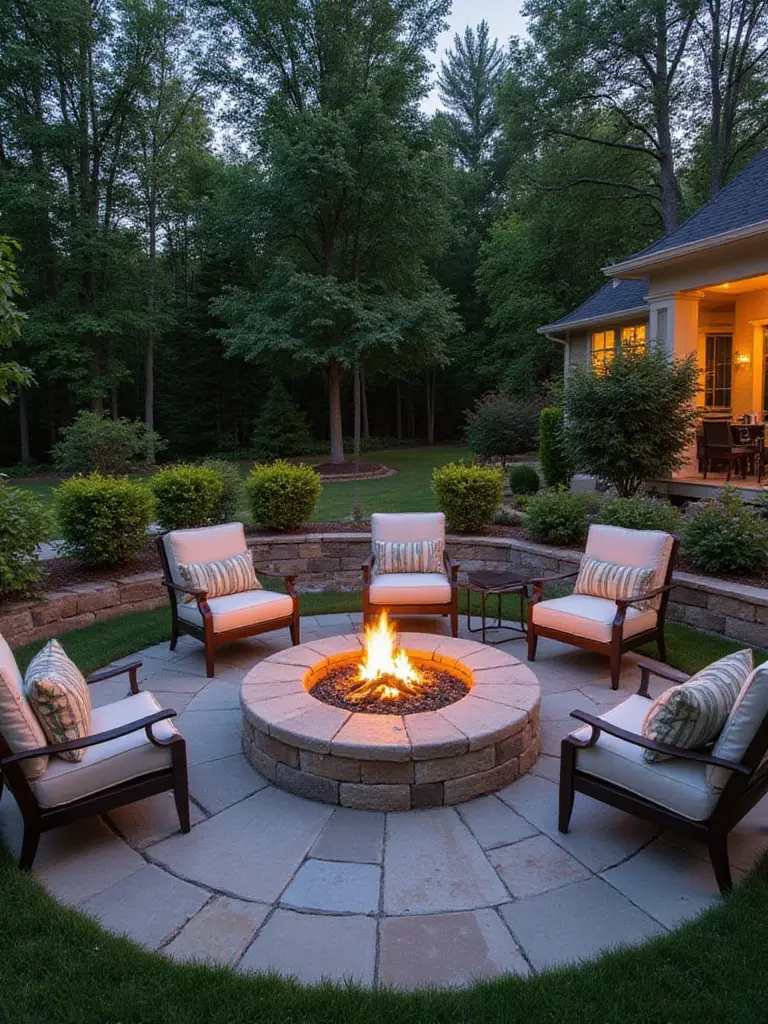
If your landscape is full of soft, curving garden beds, a rigid, square firepit might feel jarring. A circular or free-form shape might be more appropriate. If your architecture is sharp and modern, a clean, concrete rectangle will feel right at home. The goal is to make the entire outdoor space feel like a single, cohesive thought. You’re creating an outdoor room, and just like indoors, all the “furniture” should speak the same design language.
Good design is a quiet conversation between all the elements in a space.
Enhancing the Firepit Experience & Ambiance
Now that the structure is sound and beautiful, let’s talk about the final layers. These are the details that transform a well-designed space into an irresistible one. This is about engaging the senses—touch, sound, and sight—to create an atmosphere that truly feels like an escape.
13. Curate Comfortable and Weather-Resistant Seating
I’m going to say something controversial: comfortable seating is more important than the firepit itself. A stunning firepit with terrible seating will be used rarely. A simple fire bowl with deep, inviting chairs you can sink into will become the most-used spot in your home. Stop thinking about “outdoor furniture” and start thinking about “furniture that happens to be outdoors.” It should be just as comfortable as your living room sofa.
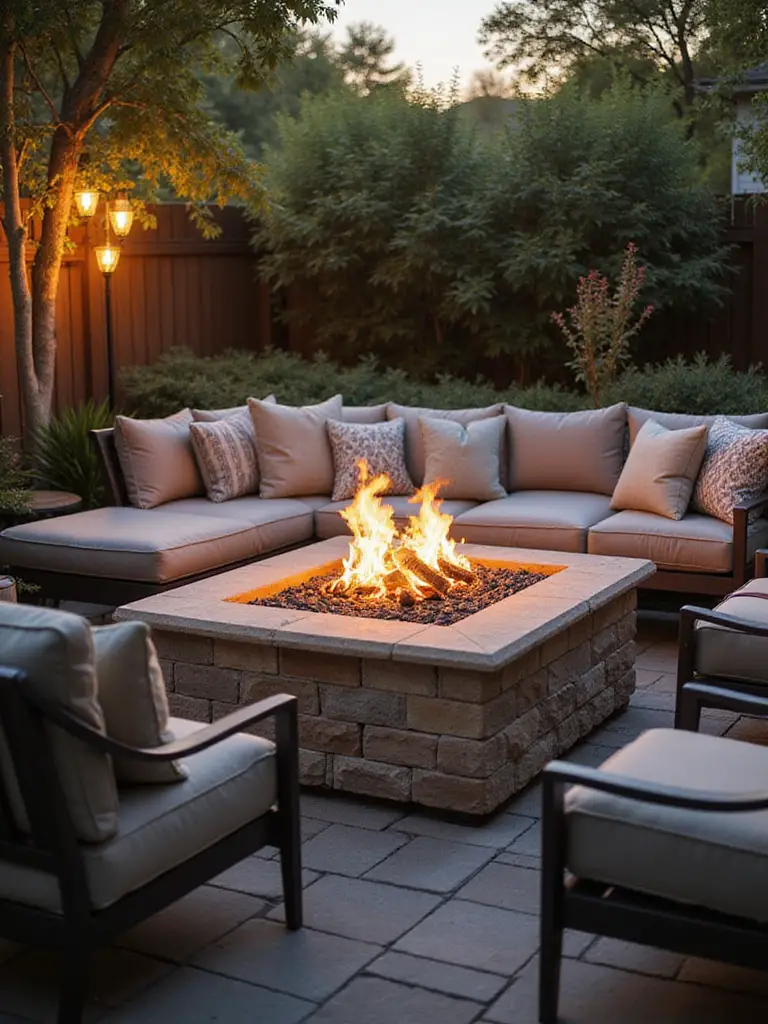
This means deep cushions, supportive backs, and fabrics that feel good against your skin. Invest in high-performance materials like solution-dyed acrylic fabrics and quick-dry foam—they’re a godsend. And please, think about texture and warmth. A few beautiful, weatherproof throws can make all the difference on a cool evening, inviting guests to wrap themselves up and stay longer. This is the heart of Scandinavian hygge—creating an atmosphere of cozy contentment.
Don’t furnish a patio; create an outdoor lounge.
14. Install Layered, Ambient Lighting
The number one mistake people make with outdoor lighting is over-lighting. They install harsh floodlights that kill the mood and wash out the magic of the night sky. The fire should be the star of the show. All other light should be there to support it, not compete with it. The key is to layer your light.
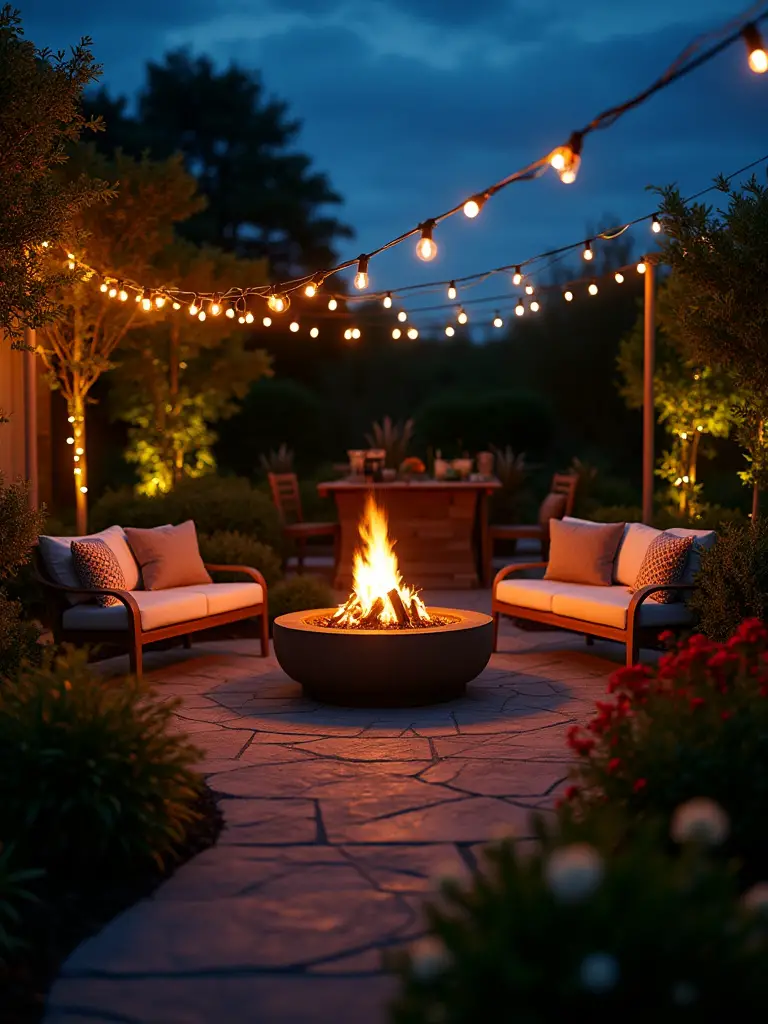
Use low-voltage path lights to softly illuminate walkways for safety. Use subtle uplights to highlight the beautiful texture of a tree trunk or a stone wall. Use warm, gentle string lights or lanterns to create a festive, human-scale glow over the seating area. Everything should be on a dimmer. This allows you to adjust the mood, turning the lights down low once the fire is roaring, letting the firelight and starlight take over.
Think of it as painting with light, creating pools of warmth and pockets of mystery.
15. Design Clever and Beautiful Storage
Storage isn’t about hiding things; it’s about creating an elegant home for them. A messy pile of firewood or a clutter of fire-tending tools creates visual noise that disrupts the calm of the space. Integrated storage, on the other hand, can be a beautiful architectural element in its own right. A niche built into a masonry wall to hold firewood becomes a feature, its texture and form adding to the overall design.

Think about designing a bench with a hinged lid for storing cushions and throws. Consider a small, recessed cabinet for lighters and s’mores supplies. The goal is to make everything you need easily accessible but thoughtfully contained. It’s the “place for everything, and everything in its place” philosophy applied to the outdoors. It respects the objects by giving them a proper home and respects the space by keeping it serene and uncluttered.
Good storage design creates a sense of calm readiness.
16. Incorporate Outdoor Speakers for Ambiance
Sound is a powerful, often overlooked, layer of design. The right music or ambient sound can completely change the feel of a space, transporting you. The key is subtlety and quality. Don’t just bring a portable Bluetooth speaker outside. The sound is often tinny and directional. A system of well-placed, weatherproof outdoor speakers creates a seamless blanket of sound that feels like it’s coming from everywhere and nowhere at once.
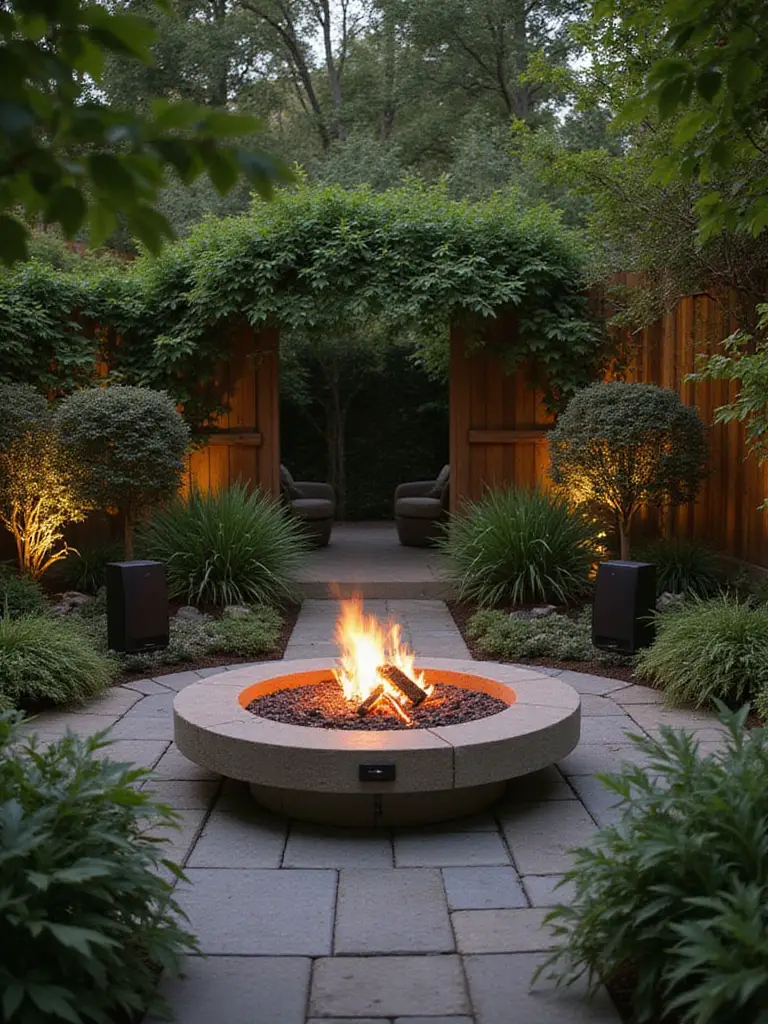
I suggest creating different “sound zones.” You might have calm, ambient music in the firepit area and something a bit more lively by the dining table. And remember, sometimes the best soundtrack is the natural one—the crickets, the wind, the crackle of the fire. A good system is one that can deliver beautiful music when you want it and disappear completely when you don’t.
Sound shouldn’t dominate the space; it should subtly color the silence.
17. Use Fire Glass or Lava Rock for Gas Fires
If you have a gas firepit, the media you fill it with is your opportunity for expression. It’s not just filler; it’s what shapes the flame. Traditional lava rock provides a dark, earthy base that makes the flames look as if they are dancing out of the ground itself. It’s primal and natural. Fire glass, on the other hand, is modern and captivating. The flames reflect off the hundreds of faceted surfaces, creating a shimmering, liquid light show.
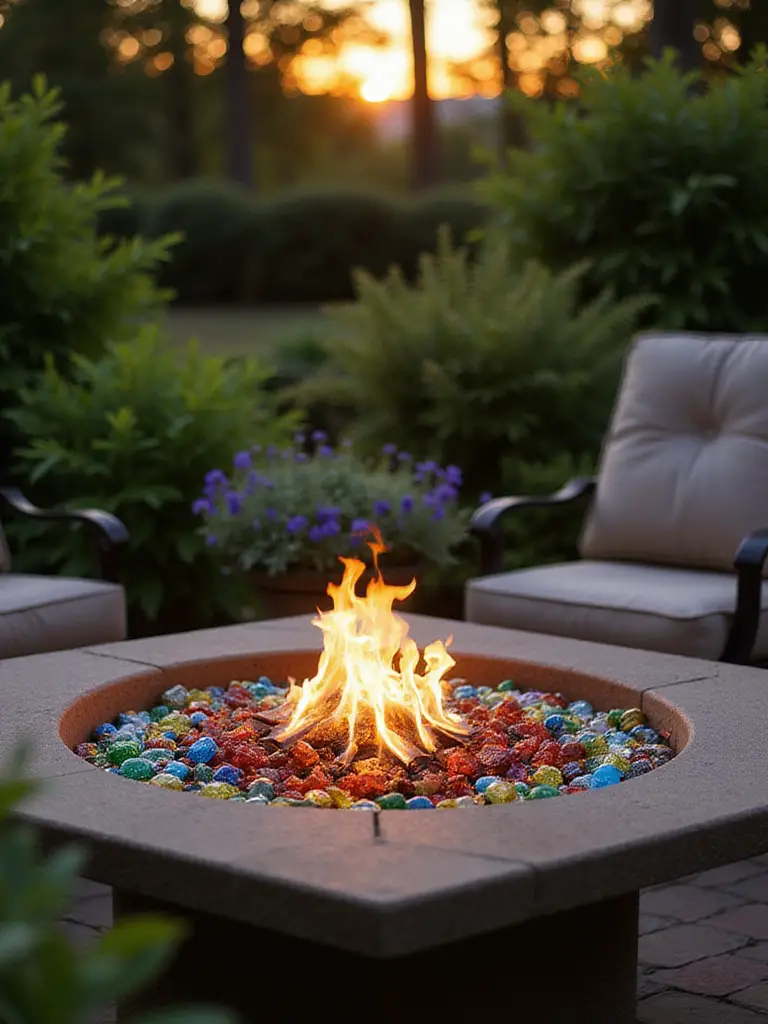
My advice is to choose a medium that reinforces your design concept. For a minimalist, contemporary space, the clean sparkle of dark fire glass is perfect. For a more rustic, organic design, lava rock feels more at home. You can even get creative by layering them—using lava rock as a base and topping it with a sprinkling of glass for a bit of unexpected sparkle. Just ensure you’re using material rated for firepits; regular glass or stone can crack or even explode when heated.
This detail is where a simple gas flame finds its personality.
18. Create a Defined Pathway
The journey to the firepit should be part of the experience. A defined path is both a practical and a poetic element. Practically, it guides guests safely, especially after dark, preventing them from stumbling through the garden. Aesthetically, it creates a sense of procession, a deliberate transition from the house or patio to this special, set-apart space.
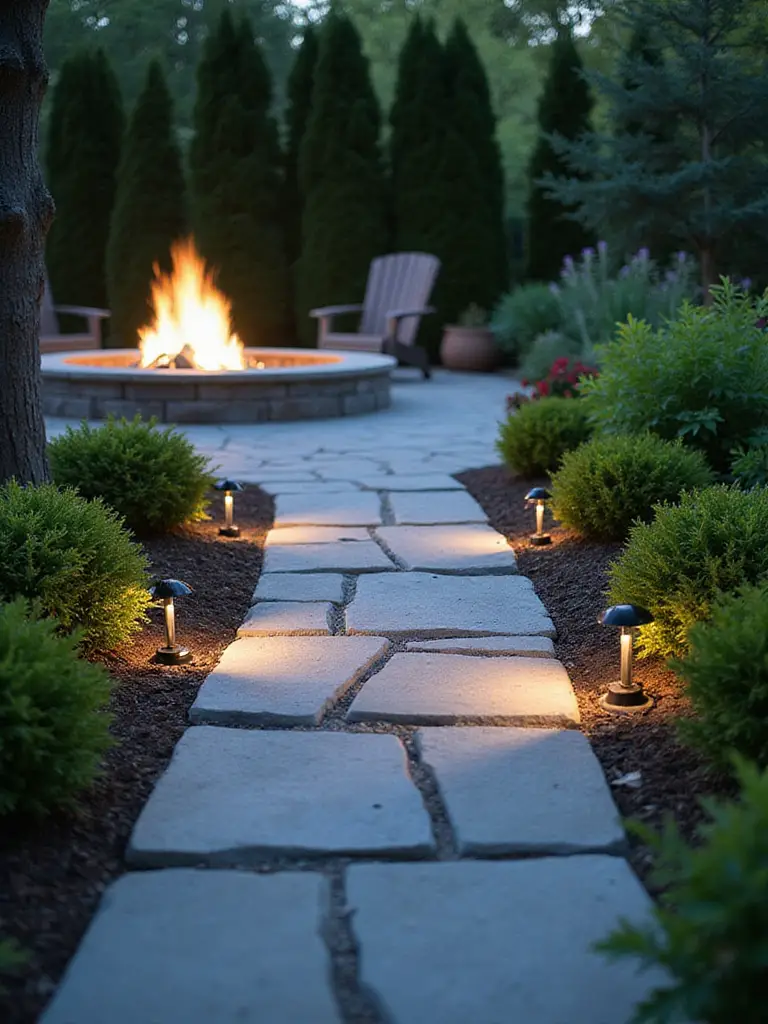
The materials matter. Simple gravel crunches satisfyingly underfoot. Large flagstones set into the lawn force a slower, more deliberate pace. A smooth concrete path feels modern and clean. Whatever you choose, integrate soft, low-level lighting along the way. The path doesn’t just lead you to the firepit; it sets the mood for the firepit.
A pathway turns a walk across the yard into a pilgrimage to warmth.
Advanced Features, Thematic Touches & Maintenance
Finally, we arrive at the personal touches that make the space uniquely yours and the practical habits that will keep it beautiful for years to come. This is about integrating specialized functions that match your lifestyle and committing to the simple acts of care that honor your investment.
19. Explore Smart Control Systems
I confess, my romantic side loves the ritual of lighting a fire by hand. But my pragmatic, climate-conscious side sees the deep intelligence in smart controls. The ability to ignite your firepit from your phone isn’t just a gimmick; it’s about efficiency. You can turn it on minutes before you step outside, so it’s ready when you are, wasting no fuel. You can set timers, so it never gets left on by accident.
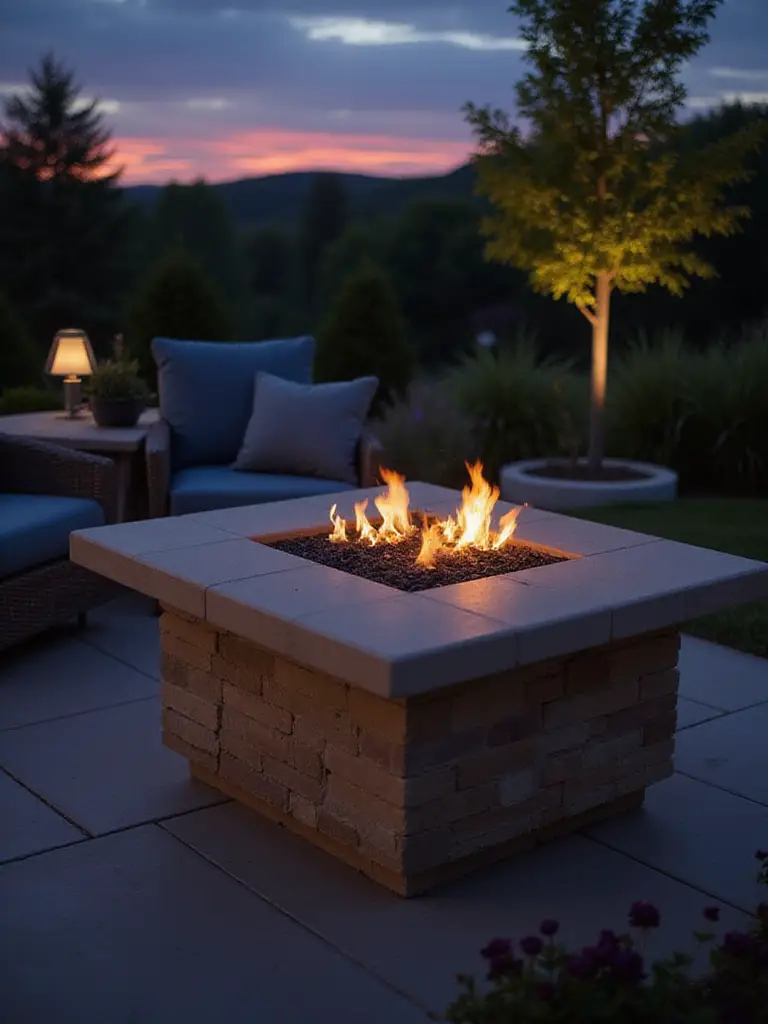
In a world where we must be mindful of our resource consumption, this kind of control is a responsible choice. It integrates a timeless element—fire—with modern technology in a way that promotes safety and conservation. For me, the real elegance lies in that efficiency. It’s the 21st-century evolution of tending the flame.
Modern convenience is at its best when it serves ancient wisdom.
20. Add a Grill Grate for Culinary Versatility
The oldest form of community gathering was cooking over a shared fire. Adding a simple grill grate to your wood-burning firepit reclaims this ancient tradition. It transforms your space from a passive place of warmth to an active place of creation and nourishment. The flavor that comes from cooking over an open wood flame is something no high-end gas grill can ever replicate. It’s smoky, elemental, and deeply satisfying.
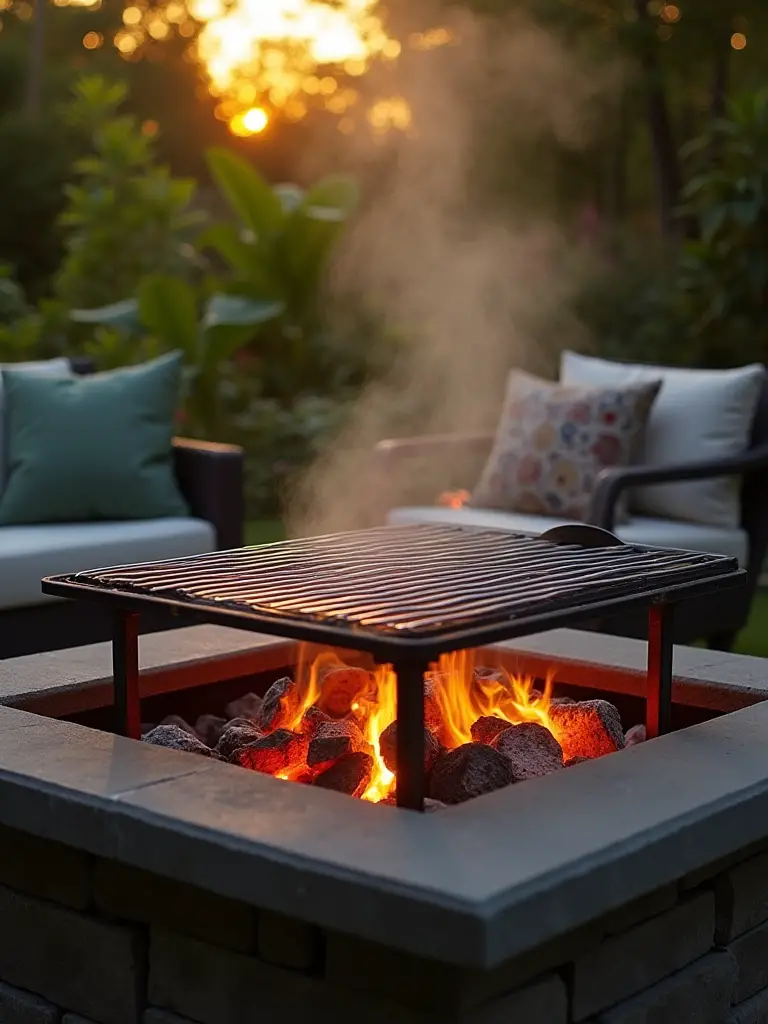
This is about more than just grilling hot dogs. Think cast-iron pans searing steaks, foil-wrapped vegetables nestled in the coals, or a pot of chili simmering slowly by the flame. It makes the firepit the undeniable center of your gathering, a place for both conversation and creation. It turns an evening into an event.
Cooking over the fire connects us to our most primal human instincts.
21. Integrate a Smoker or Pizza Oven
For those truly dedicated to the art of outdoor living, integrating a specialized cooking feature like a pizza oven or smoker creates a culinary destination. This is a serious commitment, but it elevates your backyard into a place capable of producing extraordinary food and, by extension, unforgettable gatherings. A pizza oven becomes a theater, with everyone gathering around to watch pies cook in 90 seconds. A smoker invites a slow, all-day ritual that culminates in a shared feast.
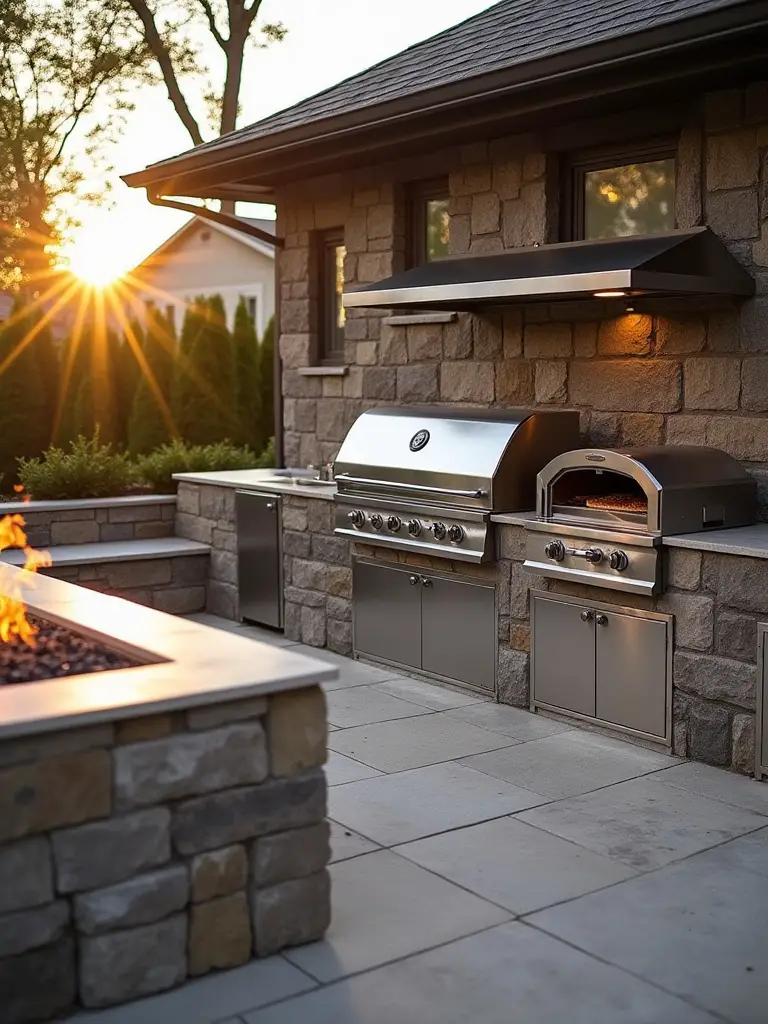
This approach blurs the line between a backyard and an outdoor kitchen. It requires thoughtful planning around ventilation, utility lines, and countertop space. But for the family or host whose life revolves around food and community, there is no greater investment. It creates a powerful anchor for social life.
This is not just about making dinner; it’s about creating a tradition.
22. Design a Dedicated S’mores Station
Let’s be honest: fumbling in the dark for marshmallows, chocolate, and graham crackers is part of no one’s ideal evening. A dedicated s’mores station is a small detail that delivers an outsized amount of joy and ease. It doesn’t have to be complicated. It can be a simple tray with lidded containers or a small, portable caddy that holds everything in its place.
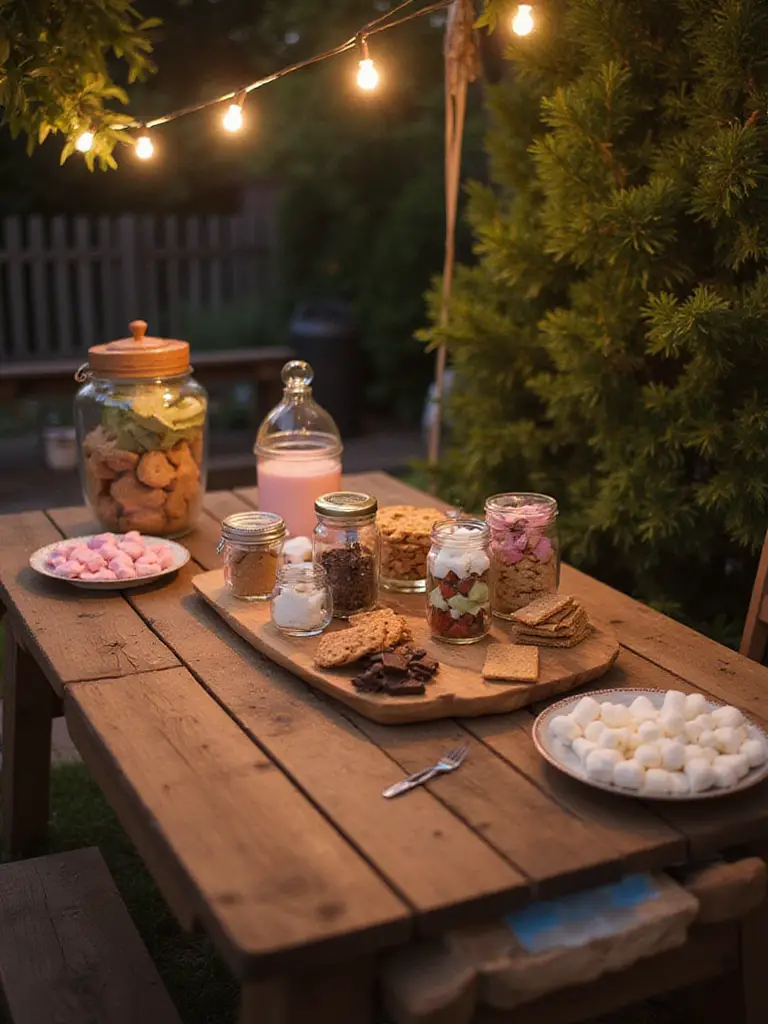
It’s a thoughtful touch that says to your family and guests, “I’ve thought about your experience.” It makes the activity feel special and organized, reducing mess and stress. For families with children, it’s a game-changer. It’s a small, elegant solution that elevates a simple, sticky treat into a delightful ritual.
The best designs anticipate needs and solve them with grace.
23. Implement a Regular Cleaning Schedule
A dirty firepit is a sad sight. Ash and soot are acidic and hold moisture, which will corrode and degrade even the most durable materials over time. Regular cleaning isn’t a chore; it’s an act of respect for the space you’ve created. For a wood firepit, this means clearing out cold ashes after every few uses. For a gas unit, it means periodically cleaning the media and ensuring the burner ports are clear.
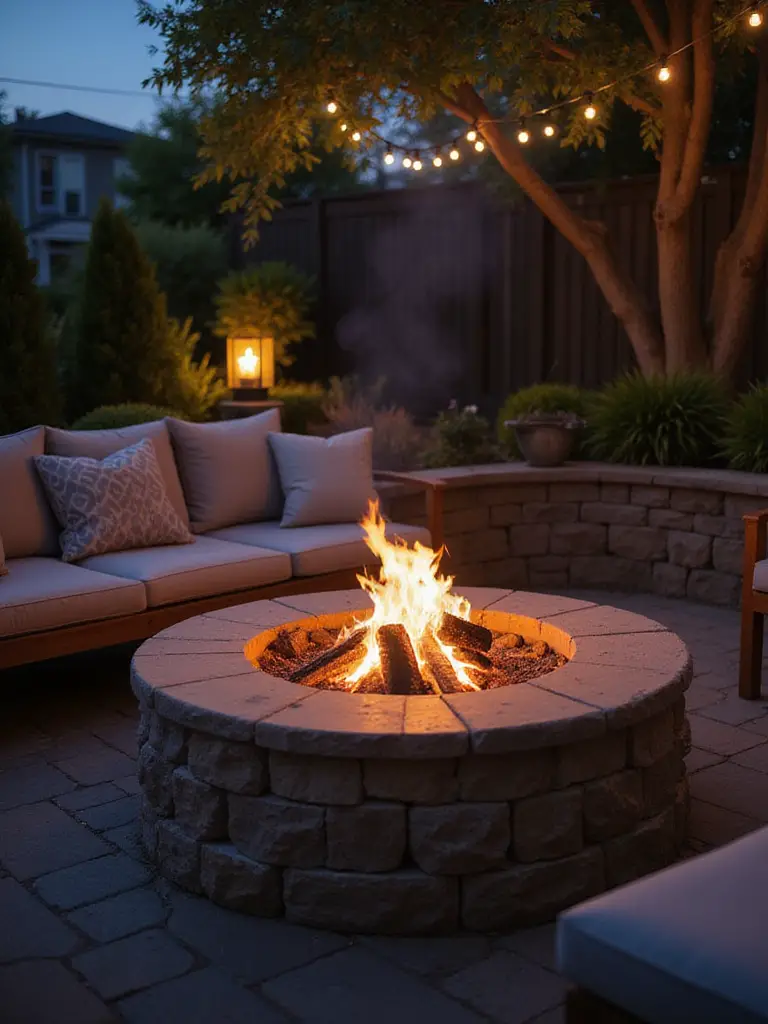
I recommend a small, dedicated wet/dry vac for this task—it makes cleanup astonishingly fast and easy. Think of it like making your bed in the morning. It’s a small ritual that resets the space, keeping it pristine, safe, and always ready for the next fire. This simple discipline is what ensures your firepit will serve you beautifully for decades, not just a few seasons.
Maintenance is the ongoing act of caring for your investment.
24. Develop a Cohesive Material and Textural Palette
Please, let’s stop calling it a “theme.” You are not creating a pirate-themed amusement park ride in your backyard. You are creating a cohesive design language. A theme is superficial; a cohesive palette is about depth. It’s about selecting a limited number of materials, colors, and textures and using them repeatedly throughout the space to create a sense of rhythm and harmony.
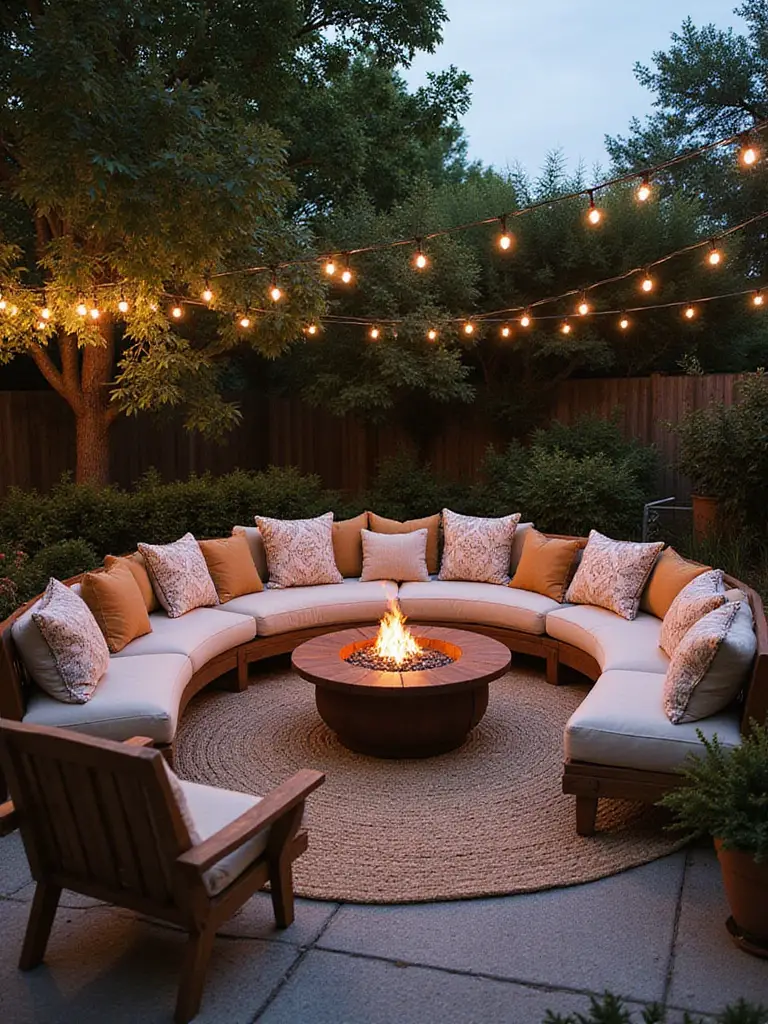
Start with the core materials of your firepit and home. Then, choose textiles—cushions, rugs, blankets—that complement that core palette. If your firepit is smooth concrete, you might introduce rough linen pillows and a chunky knit throw to provide textural contrast. It’s this interplay of textures—smooth against rough, hard against soft—that makes a space feel rich and layered, especially at night when light catches each surface differently.
A theme is a costume. A cohesive palette is the soul of the space.
Conclusion
In the end, a firepit is so much more than a feature in your backyard. It’s a destination. It is the modern expression of the ancient hearth—a magnetic force that draws us out of our homes and brings us together. By thoughtfully considering the foundation, materials, and the layered experiences around it, you’re not just building with stone and steel; you’re creating a space for connection, reflection, and quiet joy.
Whether you’re drawn to the clean simplicity of Scandinavian design, the communal spirit of a Middle Eastern courtyard, or—like me—the beautiful space where they meet, let your choices be intentional. Create a space that honors its environment, reflects your life, and holds a steady warmth for all who gather there.
